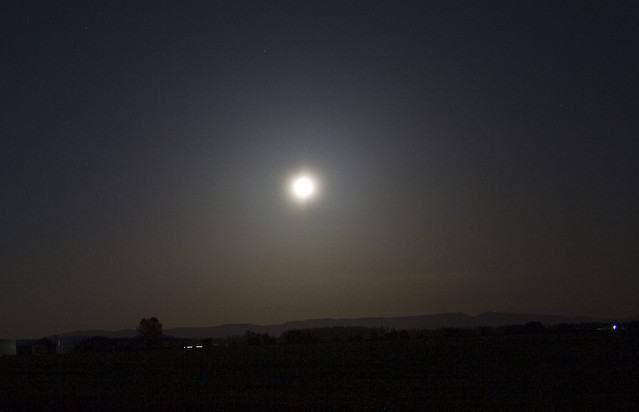
I've noticed something interesting since I started fostering Holly; black dogs are easy to see in the dark, but tan dogs are invisible after dusk. It seems counter intuitive (a lighter color should reflect more light, right?), until you go on a night walk (a necessity right now since it's dark long before I get out of work). If you're anywhere near a town, there is more than enough light pollution to see just fine after a few minutes without a flashlight. Once your eyes have adjusted, you can see that the night isn't that dark. The coal-black of a border collie's coat stands out against everything except the deepest shadow. Holly is impossible to spot until she's about 20 feet away. Sometimes you can see her white chest and tail tip moving, eerily independent of any other obvious form.
The place I go walking now adays is on some vacant land near a dry canal. Mostly we walk on the old, weed-infested service road that follows along the banks of the canal. I haven't lived here long enough to know if it will run with water come summer. Every year there are more and more abandoned canals; they're being replaced with underground pipes. Less leakage. Suits me fine. I like to walk down in the middle of the canal sometimes. It's darker and harder to see. The risk from a twisted angle is greater as there are a lot of loose rocks. But it provide amazing protection from the wind, which this time of year feels like someone pressing handfuls of ice cubes against the sides of my face even when I'm wearing a hat.
I use to do a lot of night hikes as a teenager. Sometimes with a friend, but usually by myself and the dog. I grew up was in the middle of the Oregon coastal rain forest and had miles of logging road at my disposal. I'd bring a flashlight but rarely turn it on. Even out there, with no light pollution and a heavy canopy of 40 year old Douglas fir overhead, there was usually enough light to hike with as long as you stayed on a road. Gravel actually reflects quite a bit of light and is a smooth enough surface to allow you to see obstacles, even if they are little more than dark blobs. If the path went through an area of particular blackness, I'd grab onto the dog's collar and and let him lead me.
I've never felt afraid of the dark. The opposite, in fact. When you're out in the night, and you stay quiet and don't shine a light, you become part of it. If there is any other person out there, you can hear and see them coming long before they'd see you. Darkness is camouflage and anonymity. For a shy, instinctively reclusive person like me, these are qualities you crave, deep down.
There's also the mystery that night lends to every-day objects. Two nights ago, halfway through our walk, I called the dogs over for a periotic check-in and Sammy had something dark and baseball-sized in her mouth. She refused to drop it, even for a treat. Without thinking, I reached in and pulled it from her mouth and discovered it was a half-rotted cat head.
I have a trick when I want to distract the dogs from something disgusting on the trail. In this case, I gently set the head on the ground (silently congratulating myself for suppressing the urge to throw it. I do not want to get into a game of fetch with a rotting head), grabbed two dogs by the scruffs, and run in the opposite direction. Zelda is very easy to convince to run with you, and once she's started the two younger dogs will usually follow. Thus was a cat head forgotten and neither rolled on nor eaten.

2 comments:
Golden retrievers are very hard to see at night.
Mark Derr thinks that the black color, which was one of the earliest mutations bred for in domestic dogs and then transmitted back to wolves, may have been encouraged because black dogs are easier to see at night.
I believe it. If you hunted with dogs at night, black color would be extremely noticeable.
Post a Comment